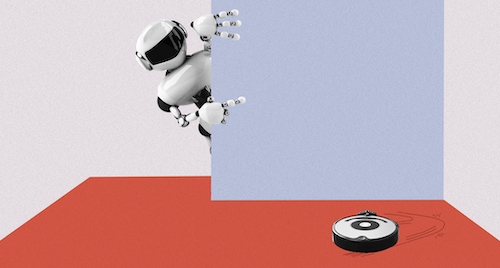
A couple weeks ago, some folks organizing the ceremonial ribbon cutting for UM-Dearborn’s new Engineering Lab Building had a really fun idea for showcasing some of the building’s flashy new technologies: Why not have one of the new robots from the robotics lab actually roll in and cut the ribbon? If you don’t work with robots every day, that sounds straightforward enough. Robotics engineers, however, are well-practiced in resetting expectations. “I mean, we could make a robot that cuts a ribbon, but it’s a pretty technical and time consuming thing,” says Associate Professor Samir Rawashdeh. “We’d need to spend the time developing a vision system so it can know what color the ribbon is, figure out its depth and position, etc. And the thing is, it’s pretty hard to do that in two weeks. Robots are very capable, they’re just not very adaptable yet.”
Rawashdeh and his colleagues Assistant Professors Jaerock Kwon and Alireza Mohammadi say it’s actually very common for people to overestimate robots’ current abilities. They all agree media probably plays the biggest role in why our expectations are so out of whack. Humanlike robots have been a feature of science fiction since the early 20th century. And more recently, things like Elon Musk boasting back in 2015 that self-driving cars would be consumer-ready by 2020, or viral videos of robots doing backflips, all contribute to the idea that this robotics stuff is easy now. (Mohammadi notes that such videos are often mashups of multiple takes, with hundreds of wipeouts cut out; not to mention the robots are almost always working in a really prescribed environment.)
We’re still waiting for fully autonomous vehicles, of course, and could be for a couple decades. But Rawashdeh thinks the public’s experience of busted expectations with AVs could actually help recalibrate our imaginations in a positive way. For sure, the dream of creating humanlike robots that can move and do things like us is still a powerful force in the field, especially, Kwon says, in places like Japan and Korea. But the robots that are more likely to show up in our daily lives are usually less anatomically like us. Probably the best real-world example is the Roomba: A humble robot with just a few sensors that Kwon, Mohammadi and Rawashdeh all describe as “genius.” “Roomba is a very good example of a fantastic engineering solution that uses behavior-based robotics,” Kwon says. “We can talk all we want about fancy robots, but to implement a solution at that price, with that kind of simplicity — that’s a genius thing. I mean, I was actually really inspired by the Roomba. This is what we mean when we say we need to adjust our vision for what a good robot is.”
Viewed through this paradigmatic lens, the applications for robots in our near future look far more expansive. Kwon says delivery robots are definitely one area to watch. He’s aware of at least one company in Korea that is now offering restaurant server robots for a monthly fee of $400. Distinctly unhumanlike, they look more like futuristic shelving units on wheels with an attached touchscreen, but they get the job done. Similarly, in urban Japanese highrises, delivery drivers now just drop off takeout and packages at building lobbies, saving the final bit of work for squat transport robots that can handle an elevator trip to the resident’s door on their own.
Mohammadi points out that the factory floor is one place that’s already been radically transformed by robots, though that remains out of sight if you don’t work in manufacturing. Still, that space is poised for more transformation. The typical setup nowadays is to have large industrial robots do one set of tasks and human workers do others. But due to safety concerns, it’s rare to have humans and robots working in the same space. New “cobots” (short for collaborative robots) could change that. Equipped with safety algorithms, these robots are facilitating new work environments where humans and robots become something akin to co-workers. “The human worker might do something that’s easy for humans to do, like part identification or moving a component into the proper position,” Mohammadi explains. “And then the cobot would do the mechanical work, like welding or screwing in the part.”
One other area to watch: powered exoskeletons. Before your mind goes there, these aren’t like the cyborgsuit weapons from Matrix Revolutions. Instead, picture intelligent knee braces that could help people recover mobility; or robotic arm attachments that could give factory workers superhuman strength for manipulating heavy or oversized materials.
The future of robotics, in other words, will still be fueled by the wildness of our imaginations. But it will also be guided by the realization that robots’ greatest potential may come from refining their scope. Our greatest successes may lie in not asking too much of our robots — or for them to be too much like us. Working alongside them, we can pitch in with parts of tasks that are still easier for us to do, while letting them do things they can be cheaply programmed for — and then we still might have to help if they occasionally get stuck. In other words, the future might be a little less C-3PO, Bender, Rosie or Optimus Prime, and a little more Roomba. And we can learn to be OK with that.
###
Story by Blouin. By the way, Mohammadi and his students came up with a workable Plan B for the ribbon cutting: With the tight timeline, they were able to have a couple of their mobile robots greet visitors and deliver the scissors. If you’re a member of the media and would like to talk with Kwon, Rawashdeh and Mohammadi about the future of robotics, drop us a line at UMDearborn-News@umich.edu and we’ll put you in touch.




